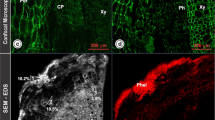Abstract
Acid rain solubilises aluminum which can exert toxic effects on soil bacteria. The root nodule bacterium Rhizobium leguminosarum biovar viciae synthesises the hydroxamate siderophore vicibactin in response to iron limitation. We report the effect of vicibactin on the toxicity of aluminum(III) to R. leguminosarum and kinetic studies on the reaction of vicibactin with Al(III) and Fe(III). Aluminum (added as the nitrate) completely inhibited bacterial growth at 25 μM final concentration, whereas the preformed Al-vicibactin complex had no effect. When aluminum and vicibactin solutions were added separately to growing cultures, growth was partly inhibited at 25 μM final concentration of each, but fully inhibited at 50 μM final concentration of each. Growth was not inhibited at 50 μM Al and 100 μM vicibactin, probably reflecting the slow reaction between Al and vicibactin; this results in some aluminum remaining uncomplexed long enough to exert toxic effects on growth, partly at 25 μM Al and vicibactin and fully at 50 μM Al and vicibactin. At 100 μM vicibactin and 50 μM Al, Al was complexed more effectively and there was no toxic effect. It was anticipated that vicibactin might enhance the toxicity of Al by transporting it into the cell, but the Al-vicibactin complex was not toxic. Several explanations are possible: the Al-vicibactin complex is not taken up by the cell; the complex is taken up but Al is not released from vicibactin; Al is released in the cell but is precipitated immediately. However, vicibactin reduces the toxicity of Al by complexing it outside the cell.
Similar content being viewed by others
References
Booth IR. 1985 Regulation of cytoplasmic pH in bacteria. Microbiol Rev 49: 359–378.
Brown CM, Dilworth MJ. 1975 Ammonia assimilation by Rhizobium cultures and bacteroids. J Gen Microbiol 86, 39–48.
Byers BR, Powell MV, Lankford CE. 1967 Iron-chelating hydroxamic acid (schizokinen) active in initiation of cell division in Bacillus megaterium. J Bacteriol 93, 286–294.
Carson KC, Holliday S, Glenn AR, and Dilworth MJ. 1992a Siderophore and organic acid production in root nodule bacteria. Arch Microbiol 157, 264–271.
Carson KC, Dilworth MJ, Glenn AR. 1992b Siderophore production and iron transport in Rhizobium leguminosarum bv. viciae WSM710. J Plant Nutr 15: 2203–2220.
Carson KC, Dilworth MJ, Glenn AR. 1994 Specificity of siderophore-mediated transport of iron in rhizobia. Arch Microbiol 161, 333–339.
Carson KC, Meyer JM, Dilworth MJ. 2000 Hydroxamate siderophores of root nodule bacteria. Soil Biol Biochem 32, 11–21.
Davis WB, McCauley MJ, Byers BR. 1971 Iron requirements and aluminum sensitivity of an hydroxamic acid-requiring strain of Bacillus megaterium. J Bacteriol 105, 589–594.
Dilworth MJ, Carson KC, Giles RGF, Byrne LT, Glenn AR. 1998 Rhizobium leguminosarum bv. viciae produces a novel cyclic trihydroxamate siderophore, vicibactin. Microbiology 144, 781–791.
Emery T. 1971 Role of ferrichrome as a ferric ionophore in Ustilago sphaerogena. Biochemistry 10, 1483–1488.
Emery T, Hoffer PB. 1980 Siderophore-mediated mechanism of gallium uptake demonstrated in the microorganism Ustilago sphaerogena. J Nuclear Med 21, 935–939.
Evers A, Hancock RD, Martell AE, Motekaitis RJ. 1989 Metal ion recognition in ligands with negatively charged oxygen donor groups. Complexation of Fe(III), Ga(III), In(III), Al(III) and other highly charged metal ions. Inorg Chem 28, 2189–2195.
Fabiano E, Gill PR, Noya F, Bagnasco P, Delafuente L, Arias A. 1995 Siderophore-mediated iron acquisition mutant in Rhizobium meliloti and its effect on the nodulation kinetics of alfalfa nodules. Symbiosis 19, 197–211.
Flis SE, Glenn AR, Dilworth MJ. 1993 The interaction between aluminum and root nodule bacteria. Soil Biol Biochem 25, 403–417.
Garrison JM, Crumbliss AL. 1986 Kinetics and mechanism of aluminum(III)/siderophore ligand exchange: mono(desferriferrioxamine B)-aluminum(III) formation and dissociation in aqueous acid solution. Inorg Chim Acta 138, 61–65.
Hu X, Boyer GL. 1996 Siderophore-mediated aluminum uptake by Bacillus megaterium ATCC 19213. Appl Environ Microbiol. 62, 4044–4048.
Hughes MN, Poole RK. 1989 Metals and Micro-organisms. London: Chapman and Hall
Jadhav RS, Desai A. 1994 Role of siderophore in iron uptake in cowpea Rhizobium gn1 (peanut isolate)-possible involvement of iron repressible outer membrane proteins. FEMS Microbiol Lett 115, 185–189.
Levier K, Guerinot M-L. 1996 The Bradyrhizobium japonicum fegA gene encodes an iron-regulated outer membrane protein with similarity to hydroxamate-type siderophore receptors. J Bacteriol 178, 7265–7275.
Neilands JB. 1952 A crystalline organo-iron pigment from the smut fungus Ustilago sphaerogena. J Amer Chem Soc 74, 4846–4847.
O'Hara GW, Goss TJ, Dilworth MJ, Glenn AR. 1989 Maintenance of intracellular pH and acid tolerance in Rhizobium meliloti. Appl Environ Microbiol 55, 1870–1876.
Patel HN, Chakrabarty RN, Desai SB. 1994 Effect of iron on siderophore production on outer membrane proteins of Rhizobium leguminosarum IARI 102. Curr Microbiol 28, 119–121.
Reigh G, O'Connell M. 1993 Siderophore-mediated iron transport correlates with the presence of specific iron-regulated proteins in the outer membrane of Rhizobium meliloti. J Bacteriol 175, 94–102.
Ritchie GSP. 1995 Soluble aluminum in acidic soils: principles and practicalities. In: Date RA et al., eds. Plant Soil Interactions at Low pH. Dordrecht: Kluwer Academic Publishers: 23–33.
Roy N, Bhattacharyya P, Chakrabarty PK. 1994 Iron acquisition during growth in an iron-deficient medium by Rhizobium spp. isolated from Cicer arietinum. Microbiology 140, 2811–2820.
Smith MJ, Neilands JB. 1984 Rhizobactin, a siderophore from Rhizobium meliloti. J Plant Nutr 7, 449–458.
Watteau F, Berthelin J. 1994 Microbial dissolution of iron and aluminum from soil minerals: efficiency and specificity of hydroxamate siderophores compared to aliphatic acids. Eur J Soil Biol 30, 1–9.
Author information
Authors and Affiliations
Rights and permissions
About this article
Cite this article
Rogers, N.J., Carson, K.C., Glenn, A.R. et al. Alleviation of aluminum toxicity to Rhizobium leguminosarum bv. viciae by the hydroxamate siderophore vicibactin. Biometals 14, 59–66 (2001). https://doi.org/10.1023/A:1016691301330
Issue Date:
DOI: https://doi.org/10.1023/A:1016691301330




